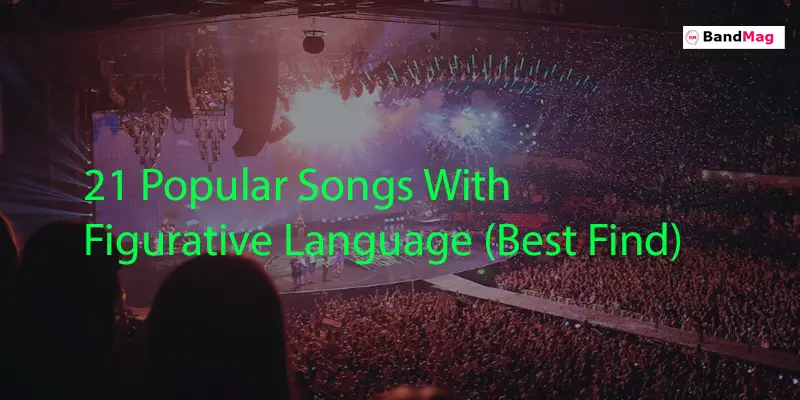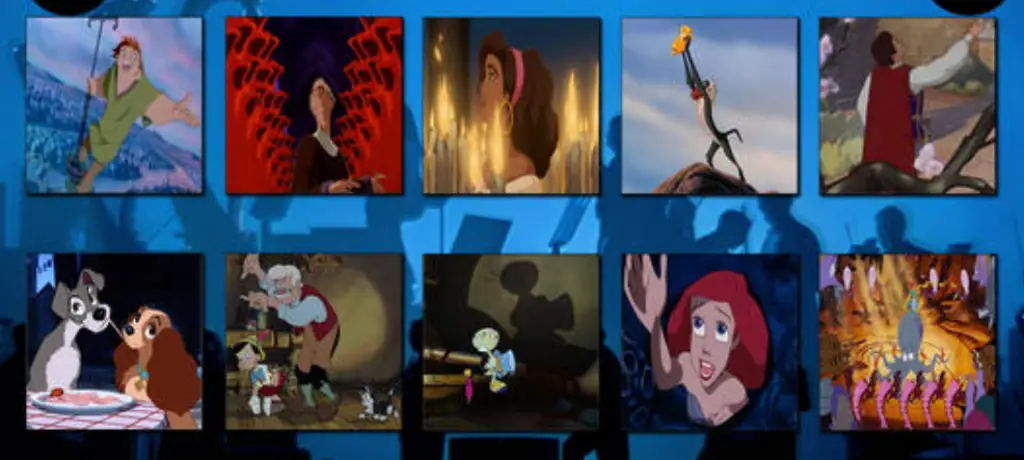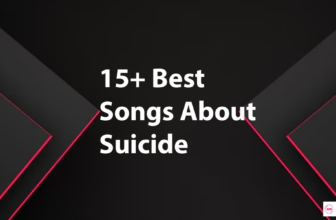
Are you looking for popular songs with figurative language?
Music has always been a potent medium for expressing emotions and painting vivid images in listeners’ minds.
One of the beauties of songwriting is the ingenious use of figurative language to add depth, evoke emotion, and connect with the audience personally.
From the storytelling prowess of Taylor Swift to the lyrical depth of classic rap songs, figurative language plays a pivotal role in transforming simple melodies into timeless pieces of art.
This blog post explores the rich landscape of popular songs that masterfully employ figurative language.
Whether you’re a songwriter seeking inspiration, a music lover appreciating the craft, or someone intrigued by the power of words, you’ll find this exploration both enlightening and entertaining.
List of the Best Songs with Figurative Language
1. Love Story (Taylor Swift)
Taylor Swift’s “Love Story” is a perfect example of a song with figurative language. Throughout the song, Taylor uses metaphors to describe her love for someone.
For instance, she compares their relationship to Romeo and Juliet by saying, “We were both young when I first saw you. I closed my eyes, and the flashback started. I’m standing there on a balcony in summer air.”
This line not only references the famous Shakespeare play but also creates a romantic and nostalgic feeling for the listener. Taylor also uses personification when she says, “So I sneak out to the garden to see you / We keep quiet ’cause we’re dead if they knew.”
Giving human qualities to the garden adds depth to the lyrics and further portrays the secretive and forbidden nature of their love. This is one of the Popular Songs With Figurative Language.
2. Firework (Katy Perry)
“Firework” by Katy Perry is a song filled with imagery and figurative language. The central theme is self-empowerment and embracing one’s uniqueness.
Throughout the lyrics, Katy uses metaphors such as “You don’t have to feel like a wasted space” and “You’re original, cannot be replaced” to encourage listeners to embrace their individuality and recognize their self-worth.
The song begins with an upbeat tempo and powerful vocals from Katy, who sings about feeling lost and invisible.
She compares herself to a firework hidden within the darkness, waiting to shine. This metaphor symbolizes the hidden potential and inner strength that we all possess but may be afraid to show.
3. Hungry Like the Wolf (Duran Duran)
Written by Simon Le Bon, Nick Rhodes, John Taylor, Roger Taylor, and Andy Taylor, “Hungry Like the Wolf” is a song by the English new wave band Duran Duran.
Released in 1982 as the band’s fifth single, it became their first top 10 hit in the United Kingdom and United States, reaching No. 5 on the UK Singles Chart and No. 3 on the US Billboard Hot 100.
The song’s music video was filmed in Sri Lanka and showcased the band members on a wild jungle adventure.
4. A Thousand Miles (Vanessa Carlton)
“A Thousand Miles” by Vanessa Carlton is a piano-driven pop ballad released in 2002. The lyrics tell the story of longing and distance, with imagery like “Making my way downtown, walking fast, faces pass, and I’m homebound.”
This line shows someone yearning to return home, facing obstacles, and feeling far away. The catchy chorus and repetition of “And I need you, and I miss you” captures the emotions of missing someone deeply.
The music video for “A Thousand Miles” is iconic. It features Vanessa Carlton playing a grand piano on the back of a moving truck as it travels through different landscapes.
This visual representation further emphasizes the theme of longing and distance in the lyrics.
Overall, these songs all showcase the power of music to capture and express human emotions.
Whether feeling lost, invisible, or far away from loved ones, these artists have used their talents to create songs that resonate with audiences and make them feel seen and understood.
5. Broken Home (5 Seconds of Summer)
“Broken Home” by 5 Seconds of Summer is a powerful ballad that dives deep into the emotional turmoil of a family falling apart.
The song vividly illustrates the pain and confusion experienced by children caught in the crossfire of their parents’ relationship struggles through its poignant lyrics.
Using figurative language enriches the narrative, vividly depicting the household’s fractured reality.
Lines like “We’re a Broken Home” convey the literal separation within the family and the emotional disconnection that resonates with many listeners, making it a compelling example of how music can encapsulate complex emotional experiences.
6. Carousel (Melanie Martinez)
“Carousel” by Melanie Martinez expertly weaves a tapestry of metaphor and simile to depict a toxic relationship’s dizzying, circular nature.
Through its haunting melody and evocative lyrics, the song likens the emotional turmoil and repetitive cycles of an unhealthy romance to being stuck on a carnival ride.
Martinez’s use of vivid, immersive language not only captivates listeners but also paints a picture of the desperation and confusion felt when unable to escape the ups and downs of doomed love.
This track stands out as a brilliant example of how figurative language can deepen the emotional impact of music, making abstract feelings tangibly relatable.
7. Scars to Your Beautiful (Alessia Cara)
“Alessia Cara’s ‘Scars to Your Beautiful’ is a poignant anthem that addresses societal beauty standards and self-acceptance.
The song uses metaphorical language through its compelling lyrics to convey that true beauty goes beyond the superficial and is found within. Cara encourages listeners to see past societal pressures and to recognize and celebrate their unique beauty.
This track showcases Cara’s vocal talent and her ability to connect with listeners on a deep, emotional level through figurative language.” This is one of the most famous Songs With Figurative Language.
8. Imagination (Shawn Mendes)
“Imagination” by Shawn Mendes is a brilliant showcase of figurative language, weaving imagery and metaphors seamlessly throughout the lyrics.
Mendes uses vivid descriptions to paint a picture of a love that’s both intense and unattainable, touching on themes of longing and desire.
The song’s narrative is rich in emotional depth, allowing listeners to glide through the story Mendes crafts with his words effortlessly. It exemplifies how music can transcend mere sound, becoming a canvas for storytelling and emotional expression.
Through “Imagination,” Mendes invites his audience into a world of romantic fantasy, highlighting the power of love and the pain of yearning.
9. Amnesia (5 Seconds of Summer)
“Amnesia” by 5 Seconds of Summer is a heart-wrenching ballad that masterfully employs figurative language to convey the despair of losing a loved one and the wishful thinking of erasing painful memories.
The song’s lyrics, “I wish that I could wake up with amnesia and forget about the stupid little things,” use metaphor to express a deep yearning to forget past hurt, highlighting the emotional turmoil that often accompanies a breakup.
This song resonates with listeners through its poetic articulation of a universal human experience— the longing to forget heartache and start anew.
10. Mercy (Shawn Mendes)
“Mercy” by Shawn Mendes is a powerful ballad that masterfully showcases figurative language, elevating the emotional weight of the song’s plea for compassion.
Mendes uses vivid imagery and metaphors to articulate the vulnerability and desperation felt when one’s heart is at the mercy of another’s actions.
The song’s lyrical depth, combined with Mendes’s passionate delivery, creates a resonant message about the intensity of love and the pain of unrequited emotions.
This track stands out for its raw emotional energy and clever use of language to convey complex feelings, making it a prime example of the effective use of figurative language in music.
11. Fireflies (Owl City)
“Fireflies” by Owl City is a mesmerizing track showcasing an incredible use of figurative language, turning it into more than just a song—a vivid dreamscape.
The lyrics are awash with imaginative metaphors and vivid imagery, such as likening fireflies to lamps and the night sky to an open canvas.
This song stands out for its ability to transport listeners to a whimsical world through its creative language, engaging them in a universe where the mundane becomes magical.
The song’s ethereal sound, combined with lyrical creativity, captures the essence of nostalgia and the boundless possibilities of imagination, making it a perfect exemplar of figurative language in music.
12. Life is a Highway (Rascal Flatts)
“Life is a Highway” by Rascal Flatts is more than just a catchy tune; it’s a symbolic masterpiece that equates life’s journey with the sprawling, unpredictable nature of the road.
This song beautifully encapsulates the essence of life’s ups and downs, twists and turns, much like the highways we travel. It suggests that, regardless of our challenges, the key is to keep moving forward and driving along the road of life.
Its use of vibrant imagery and comparisons deeply resonates with listeners, making it a memorable musical piece and a profound reflection on life itself.
13. She’s Everything (Brad Paisley)
“She’s Everything” by Brad Paisley is a testament to the powerful use of figurative language in songwriting.
Through a blend of metaphors and similes, Paisley paints a vivid picture of his love and admiration for the woman in his life. The song’s lyrics articulate universal and deeply personal emotions, making it relatable to a broad audience.
His ability to evoke imagery, such as comparing his partner to a Sunday morning and a Saturday night, encapsulates the multifaceted nature of love. This track showcases Paisley’s skill as a lyricist and his understanding of the human heart.
14. Theme From New York (Frank Sinatra)
“Theme from New York, New York,” as performed by Frank Sinatra, serves as a timeless anthem for the city that never sleeps. The lyrics, penned with artful use of figurative language, paint a vivid picture of the aspirational and resilient spirit of New York City.
Phrases like “I want to wake up in a city that never sleeps” and “If I can make it there, I’ll make it anywhere” capture the ambitious essence of its residents. With its charismatic delivery and grandiose orchestration, Sinatra’s rendition encapsulates the hope, dreams, and indomitable will of those seeking success and affirmation in the bustling metropolis.
This song not only celebrates the city’s iconic status but also inspires listeners with its message of perseverance and the pursuit of dreams.
15. Stereo Hearts (Gym Class Heroes)
“Stereo Hearts” by Gym Class Heroes, featuring Adam Levine, is a perfect exemplar of utilizing figurative language to weave intricate emotional narratives in music.
The song cleverly uses the metaphor of a stereo as a heart, illustrating the depth of connection and harmony between lovers. The lyrics, “My heart’s a stereo / It beats for you, so listen close,” invite listeners into vivid imagery of love being broadcast like a favorite tune, symbolizing how deeply entwined the speaker’s emotions are with the listener’s presence.
This imaginative use of metaphor enriches the song’s lyrical composition and highlights the universal nature of music and emotions, resonating with a broad audience.
16. Grenade (Bruno Mars)
“Bruno Mars’ hit song Grenade masterfully employs figurative language to express the depths of sacrificial love and heartbreak.
Through vivid metaphors and hyperbole, Mars illustrates how much he would go for his loved one, saying he’d catch a grenade, throw his hand on a blade, and jump in front of a train.
This intense imagery captures the listener’s imagination and conveys the pain and disillusionment of unreciprocated love.
The song’s emotional weight is heightened by its rich use of similes and metaphors, making it a powerful example of storytelling through music.”
17. Stuck Like Glue (Sugarland)
“Stuck Like Glue” by Sugarland uses a catchy melody and clever lyrics to illustrate the bond between deeply connected people.
The title is a metaphor, comparing the robust and inseparable attachment of the lyrics’ subjects to the adhesive property of glue.
This song brilliantly showcases how figurative language can convey emotions and relationships in a vibrant, relatable manner, making it a perfect example of the power of metaphors in music.
18. Moves Like Jagger (Maroon 5)
“Moves Like Jagger” by Maroon 5, featuring Christina Aguilera, is an iconic song that cleverly incorporates figurative language to draw attention to its catchy melody and engaging lyrics.
The title is a simile, comparing someone’s dance moves to those of Mick Jagger, the legendary frontman of The Rolling Stones, known for his distinctive and energetic performance style.
This comparison creates a vivid image in listeners’ minds and pays homage to Jagger’s iconic status in the music world.
The song’s use of this comparison epitomizes how figurative language can enhance the appeal of a song by embedding deeper cultural references and imagery.
19. Story of My Life (One Direction)
“Story of My Life” by One Direction is a beautifully crafted song that utilizes figurative language to convey deep emotions and tell a poignant narrative.
This track uses vivid imagery and metaphors to paint the picture of personal growth, life’s fleeting moments, and the impact of memories.
Lines like “Written on these walls are the colors that I can’t change” metaphorically represent the unforgettable experiences and moments that shape a person’s life, suggesting an inherent struggle between acceptance and desire for change.
Through its lyrical depth, the song connects with listeners personally, inviting them to reflect on their life stories.
20. Chandelier (Sia)
“Chandelier” by Sia stands out as a powerful anthem that uses vivid imagery and metaphors to explore themes of escapism, vulnerability, and the harsh realities of addiction.
Sia’s evocative lyrics, “I’m gonna swing from the chandelier, from the chandelier,” serve not only as a metaphor for letting go and indulging to the point of self-destruction but also capture a desperate cry for help and a yearning for freedom from one’s internal battles.
The song’s emotional depth is matched by its soaring vocal performance, making it a hauntingly beautiful piece that resonates with many listeners personally.
21. Bohemian Rhapsody (Queen)
“Bohemian Rhapsody” by Queen stands as a monumental masterpiece in music, seamlessly blending rock, ballad, and opera within a single track.
Its rich tapestry of lyrics weaves together a narrative full of depth, emotion, and complexity, employing an array of figurative language that captivates and intrigues the listener.
The song’s unique structure, shifting between moods and styles, mirrors the tumultuous journey of its protagonist, making it not just a musical experience but an emotional odyssey.
Freddie Mercury’s powerful vocals, combined with the band’s intricate compositions, create a timeless piece that continues to resonate with audiences worldwide, making it a perfect example of the power of figurative language in music.
22. What a Wonderful World (Louis Armstrong)
“Louie Armstrong’s What a Wonderful World stands as a testament to the power of figurative language in music, painting vivid images of the beauty and harmony in the world through its lyrics.
Armstrong’s gravelly voice brings to life scenes of blooming flowers, sacred skies, and the loving exchanges between people.
The song’s use of similes and metaphors highlights the interconnectedness of humanity and nature and encourages listeners to appreciate life’s simple pleasures.
Through its optimistic and poetic view of the world, the song reminds us of the goodness and beauty that surrounds us, often overlooked in the hustle of daily life.”
23. Thunder (Imagine Dragons)
“Thunder” by Imagine Dragons is a powerful anthem that extensively uses figurative language to convey themes of ambition, transformation, and overcoming adversity.
The song juxtaposes the singer’s past experiences of feeling out of place and dreaming of greatness with the triumphant reality of achieving his dreams, symbolized by the booming chorus.
Metaphors and imagery depict the journey from obscurity to fame, illustrating the emotional and psychological growth that accompanies pursuing one’s dreams.
This song serves as a testament to the band’s rise to success and an inspirational message to listeners, encouraging them to persevere through challenges and embrace their uniqueness.
24. Happy (Pharrell Williams)
“Happy” by Pharrell Williams is a vibrant and infectious track that has captivated audiences worldwide with its upbeat rhythm and positive lyrics.
The song employs figurative language brilliantly, using metaphors and similes to convey feelings of joy and contentment that transcend the mundane aspects of daily life.
Its repetitive chorus, “Because I’m happy,” coupled with vivid descriptions of feeling like a “room without a roof,” showcases Williams’ skillful imagery to evoke a sense of freedom and boundlessness.
This song not only encourages listeners to find happiness in their lives but also showcases the power of music to uplift and inspire.
25. God’s Plan
“God’s Plan” is a song by Canadian rapper Drake, showcasing his introspection on fate, success, and his role in the world. Released in 2018, it quickly soared to the top of the charts, becoming an anthem of gratitude and humility.
The music video, which features Drake giving away nearly a million dollars to needy people, amplifies the song’s message of generosity and the importance of giving back.
It’s a memorable track that combines catchy beats with thoughtful lyrics, reflecting on personal success while highlighting the significance of contributing to the greater good.
26. Demons (Imagine Dragons)
This song creatively employs the metaphor of a “demon” to symbolize the inner battles and personal demons individuals confront.
It delves deep into the theme of internal conflict and the complexity of human emotions. The lyrics further utilize personification to give these struggles vivid imagery, with powerful lines such as “When you feel my heat, look into my eyes / It’s where my demons hide.”
This not only emphasizes the intensity of these internal battles but also invites listeners to look deeper into the soul of the person facing them, suggesting that everyone has their demons lurking beneath the surface.
27. Let It Go (Idina Menzel)
The song “Let it Go” has captivated audiences worldwide with its potent lyrics and memorable melody. This anthem of self-empowerment and liberation encourages individuals to embrace their true selves, regardless of external judgments.
The lyrics urge listeners to release their concerns about others’ perceptions, symbolized powerfully in the line, “Don’t let them in, don’t let them see, be the good girl you always have to be.”
In this context, “good girl” serves as a metaphor for the roles and expectations society imposes, suggesting a break from these constraints to find one’s own identity and freedom.
The song’s message resonates deeply with many who feel pressured to conform, making it an enduring hit that inspires listeners to stand firm in their authenticity.
28. I Am a Rock (Simon & Garfunkel)
This incredible track by Simon & Garfunkel delves into themes of loneliness and the sensation of being disconnected from the world around us. The song masterfully uses poetic and evocative lyrics to express these complex emotions.
Particularly poignant is the line “I am a rock, I am an island,” which metaphorically illustrates how the singer isolates himself, building emotional barriers to protect against the pain of vulnerability.
Through their skillful composition and creative language, Simon & Garfunkel invite listeners into a deeply reflective experience, exploring those profound and often solitary feelings that resonate with so many.
Exploring Figurative Language in Songs
Figurative language includes several literary devices, such as metaphors, similes, personification, hyperbole, and more, to convey meanings in a more symbolic, indirect fashion.
Songs teeming with figurative language invite listeners to look beyond the surface, providing a more profound, richer experience.
Taylor Swift’s Songs with Figurative Language

Taylor Swift is a modern maestro of figurative language, using it to craft narratives that resonate worldwide.
Her song “Red” is a kaleidoscope of emotion, using a simple color to depict the complexity of a love story. “The rest of the world was black and white / But we were in screaming color,” Swift sings, employing contrast and color imagery to paint a vivid picture of a love that stands out in the mundanity of life.
Rap Songs with Figurative Language
The rap genre is rife with figurative language, as artists weave intricate narratives drawing from their experiences.
Kendrick Lamar’s “HUMBLE.” is laden with similes and metaphors, challenging societal norms and the inflated egos often seen in the music industry.
“I’m so sick and tired of the Photoshop / Show me somethin’ natural like afro on Richard Pryor,” Lamar raps, using a simile to emphasize authenticity and critique artificial beauty standards.
Disney Songs with Figurative Language

Disney songs are lauded for their catchy melodies and their ability to capture dreams and adventures through lyrics.
“A Whole New World” by Aladdin offers a dazzling example of hyperbole that expresses the boundless joy of discovering love and new experiences. “Unbelievable sights / Indescribable feeling,” the lyrics go, inviting listeners into a magical, exaggerated reality where anything is possible.
Christmas Songs with Figurative Language
Even holiday music utilizes figurative language to evoke the warmth and joy of the season.
“Winter Wonderland” personifies snow as a playful companion, “In the meadow, we can build a snowman / And pretend that he is Parson Brown.”
This song transforms a simple winter landscape into a scene brimming with life and festive imagination.
Using Figurative Language in Your Songwriting
Unlocking the power of figurative language in songwriting can elevate your work from simple tunes to profound, memorable masterpieces. Here are a few tips for songwriters:
- Draw from Personal Experience: Use metaphors and similes that are authentic to your life to bring honesty and depth to your lyrics.
- Read Widely: Exposure to various forms of literature can inspire and enhance your use of figurative language.
- Practice Makes Perfect: Experiment with different types of figurative language in your writing. The more you practice, the more naturally it will come to you.
Popular Songs with Figurative Language (FAQs)
What are some songs that use figurative language?
Some popular songs that use figurative language are “Firework” by Katy Perry, “I Will Always Love You” by Whitney Houston, “Bohemian Rhapsody” by Queen, and “Smells Like Teen Spirit” by Nirvana.
These songs use metaphors, similes, personification, and hyperbole to convey powerful emotions and create vivid imagery in listeners’ minds.
Why do songwriters use figurative language?
Songwriters use figurative language to add depth, emotion, and creativity to their lyrics. It allows them to paint a more vivid picture and convey complex emotions in a relatable and memorable way for their audience.
What Taylor Swift songs have figurative language?
Some Taylor Swift songs that use figurative language are “Love Story,” “Blank Space,” and “Shake It Off.”
These songs use metaphors, similes, and personification to tell stories and convey emotions. Overall, figurative language is a powerful tool for songwriters to add depth and creativity to their work, making it more relatable and memorable for listeners.
So, it is essential for aspiring songwriters to continuously practice and experiment with different forms of figurative language in their writing. Reading widely and being exposed to various forms of literature can also inspire and enhance one’s use of figurative language.
With dedication and practice, using metaphors and similes that are authentic to your life can bring honesty and depth to your lyrics, making them more impactful for yourself and your audience.
What song uses a metaphor?
One popular song that uses a metaphor is “Chandelier” by Sia. In the chorus, she compares herself to a chandelier, singing, “I’m gonna swing from the chandelier, from the chandelier / I’m gonna live like tomorrow doesn’t exist like it doesn’t exist.”
Using the chandelier as a metaphor for living recklessly and without consequences adds a powerful and relatable element to the song. Another example is “Halo” by Beyonce, where she compares her love for someone to a protective halo, singing, “Baby, I can see your halo / You know you’re my saving grace.”
This metaphor enhances the romantic and angelic nature of the song’s lyrics. Overall, metaphors can add depth and emotion to songs, making them more impactful for listeners.
It is important for songwriters to carefully consider the use of metaphors in their lyrics, as they can significantly enhance their music’s storytelling and emotional impact.
What songs use similes?
Many popular songs use similes in their lyrics to create vivid imagery and comparisons.
One example is “You Belong With Me” by Taylor Swift, in which she uses a simile to describe the love interest’s smile, singing, “He’s got that one smile / That could light up this whole town.”
What is 1 example of figurative language?
One example of figurative language is personification, which gives human qualities to non-human objects or animals. In the song “Firework” by Katy Perry, she uses personification when she sings, “Do you ever feel like a plastic bag / Drifting through the wind, wanting to start again?” This line gives an inanimate object (a plastic bag) human emotions and desires, enhancing the song’s message of self-empowerment.
Figurative language is an influential tool songwriters use to create vivid imagery and convey complex emotions in their music. It adds depth and creativity to lyrics, making them more memorable and impactful for listeners.
Why is figurative language used in songs?
Figurative language is used in songs for several reasons:
– It can add depth and emotion to lyrics, making them more impactful and memorable for listeners. By using metaphors, similes, personification, and other forms of figurative language, songwriters can paint a vivid picture in the minds of their audience and convey complex emotions that may be difficult to express through literal language.
– Figurative language can make lyrics more relatable and universal, allowing listeners to interpret the meaning in their way. This adds depth to the song and creates a deeper connection between the artist and their audience.
– Using figurative language in songs allows for creative expression and can make the lyrics more exciting and unique.
What are the five main types of figurative language?
The five main types of figurative language, which are crucial tools in the arsenal of songwriters and poets alike, include:
Simile: This employs “like” or “as” to compare two things, suggesting a likeness between them. For instance, describing someone’s mood as “as volatile as a summer storm” creates a vivid mental image.
Metaphor: Similar to a simile, a metaphor makes a comparison but does it directly without using “like” or “as.” An example could be “Time is a thief,” which implies that time steals moments from us without literally saying so.
Hyperbole: This is an intentional exaggeration for emphasis or humorous effect. Saying, “I’ve told you a million times,” exaggerates to make a point about frequency.
Personification: This gives human traits to non-human objects or concepts, such as when a plastic bag is described as having desires and emotions.
Synecdoche: It uses a part of something to refer to the whole, or vice versa. For instance, calling a car “wheels” is a synecdoche because the part (wheels) represents the whole car.
Onomatopoeia involves using words that imitate the sounds associated with the objects or actions they refer to, such as “buzz” for the sound bees make.
Each of these types enriches the language, making it more vivid and expressive. They are particularly effective in song lyrics and poetry, where emotional resonance and imagery are critical.
Final Words
Figurative language enriches songs, transforming them into multi-layered stories that resonate deeply with listeners.
The examples highlighted in this post barely scratch the surface of the vast treasury of songs enhanced by vivid imagery, metaphorical comparisons, and symbolic representations.
By incorporating figurative language into your songwriting or appreciating it in your favorite tunes, you can experience the profound connection between words and music—a bridge between the abstract and the concrete, the emotional and the intellectual.
Whether you’re dissecting the layered lyrics of Drake songs with figurative language or finding hidden meanings in Christmas classics, exploring figurative language in music is a rewarding journey.
For songwriters and music lovers alike, understanding and appreciating this literary craft opens up a world of expression and connection, making every melody a story and every lyric a work of art.
That’s all! You can also check out 13 Greatest Rappers From O Block Of All Time (Chicago) and Rappers with the Most Grammys of All Time.

Luisa is the Content writer at BandMag. With 5+ years experience in content writing and SEO, he loves talking about content creation, SEO and her cat.







